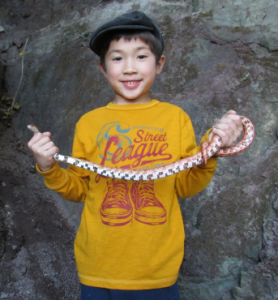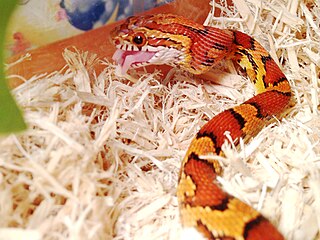Corn Snakes and Ball Pythons are close competitors for the title of the world’s most popular snake pet. Among the first species to be commercially bred in huge numbers, either makes an excellent choice for most snake owners, new or experienced. I’ve kept hundreds of species during my long career as a zookeeper, but a Corn Snake terrarium occupies center stage in my living room! In the following article I’ll compare the care needs of Corn Snakes and Ball Pythons, so that you’ll be able to plan ahead and maximize your pet-keeping experience and your new snake’s quality of life. Detailed care information is provided in the articles linked under “Further Reading”; as always, please also post any questions or observations you may have, and let me know which species gets your vote.
Although individual personalities vary, both adapt well to gentle handling and are not stressed by human contact. Corn Snakes are more likely to move about when being handled, compared to Ball Pythons, but this is offset by their lighter body weight. As with any snake, care and adult supervision must be exercised, and the animal’s head should never be allowed near one’s face.
Folks who want a “big snake in a small package” generally prefer Ball Pythons. Thick-bodied and muscular, they can average 4 feet in length, but their girth would greatly exceed that of a similarly-sized Corn Snake.
Activity Levels
Neither is overly active, but Corn Snakes regularly move between basking sites and shelters, and are more likely to wander about the cage when hungry.
Ball Pythons, native to harsh habitats, are extremely efficient at conserving energy and tend to move only when necessary.
Life Span
A Ball Python at the Philadelphia Zoo lived for a record 47.6 years, and there are anecdotal reports of a 51 year-old individual. Pets regularly survive into their 30’s.
The published longevity for a Corn Snake is 32 years, and many can approach and exceed age 20.
Breeding Potential
Both species breed reliably, and make an excellent introduction to that fascinating aspect of reptile-keeping. Each species is available in a wide variety of interesting (and even bizarre!) color morphs…at least 25 in the case of the Corn Snake. Corn Snake hybrids with King, Gopher and various Rat Snakes have also been produced. Please see the articles linked below for detailed breeding information.
Cost
The purchase price for a normally-colored individual is similar for both snakes. Prices increase for rare or unusual color morphs. This is especially true for Ball Pythons. Expenses for terrariums, supplies and electricity are similar:
Terrarium Size (single adult)
Corn Snake: 20-55 gallon
Ball Python: 30-55 gallon
Temperature
Corn Snake: 75-82 F, with a basking site of 90 F
Ball Python: 80-85 F, with a basking site of 90 F
Diet
Food intake will vary among individuals and in tune with temperature, season, life cycle stage, and other factors. While Ball pythons are much heavier than Corn Snakes and take larger meals, their habit of fasting tends to even-out food cost differences.
Ball Pythons have evolved to survive in habitats where food may be plentiful for short periods and scarce or absent at other times. Consequently, they seem predisposed to feed heavily and then to fast for weeks or even months. This can happen at any time of the year, and may be tied to circadian, or internal, rhythms. Long fasting periods may be very disconcerting to novice owners; if you prefer a regular feeder, choose a Corn Snake. Feeding preferences can change as well, with a formerly favored food, such as mice, being rejected for no apparent reason (well, none that we can discern…the snakes “know” why they do it!). When in a feed cycle, adult Ball Pythons will take 2-3 mice or 1 small rat each 10-14 days; individual intake will vary greatly, however. Please see the article linked below for more on this topic.
Corn Snakes in good health are almost always reliable feeders. Depending upon the size of the snake, they do well on 1-2 small to medium sized mice each 7-10 days.
Further Reading
 That Reptile Blog – Reptile, Amphibian and Exotic Pet Care and Information
That Reptile Blog – Reptile, Amphibian and Exotic Pet Care and Information






